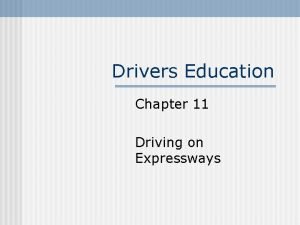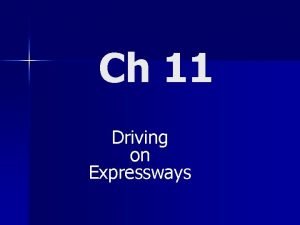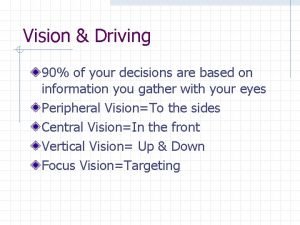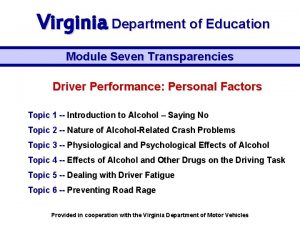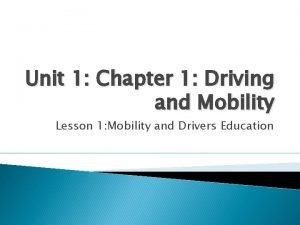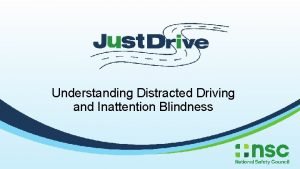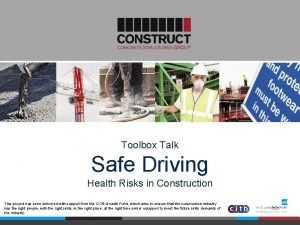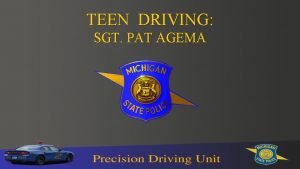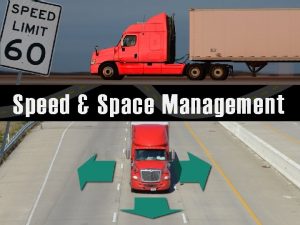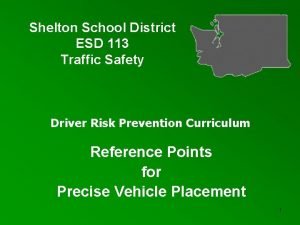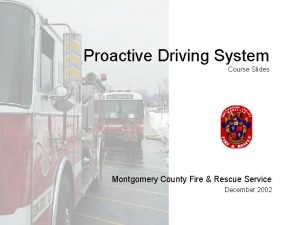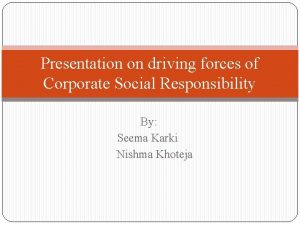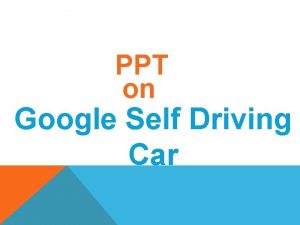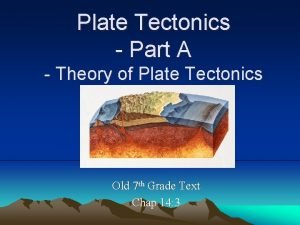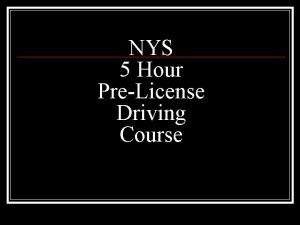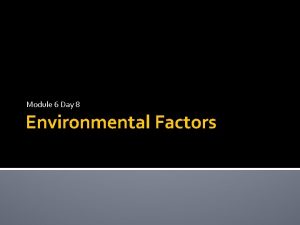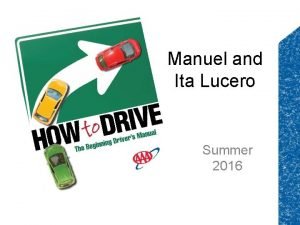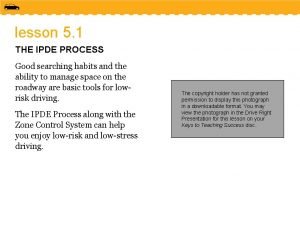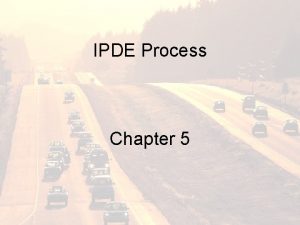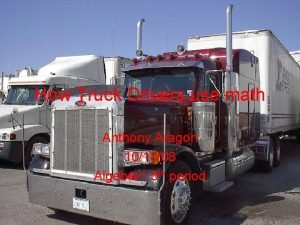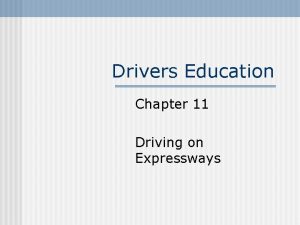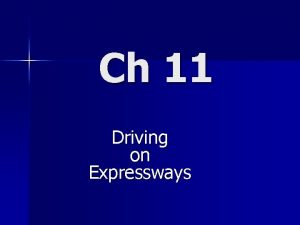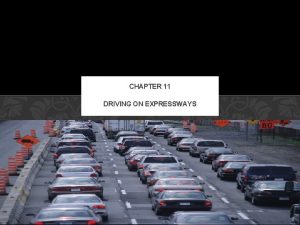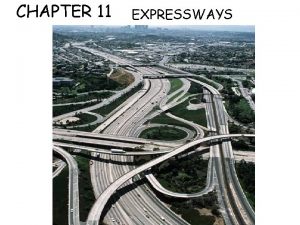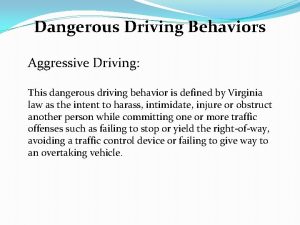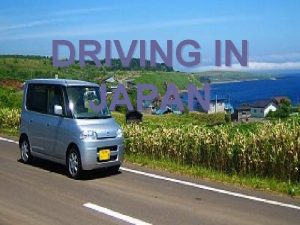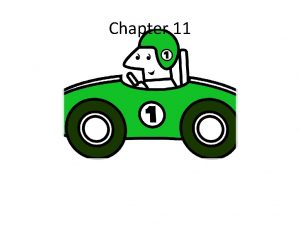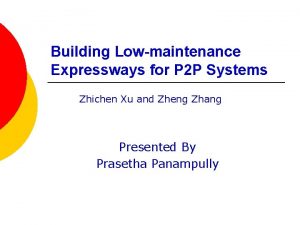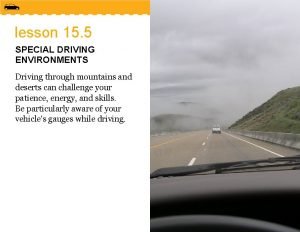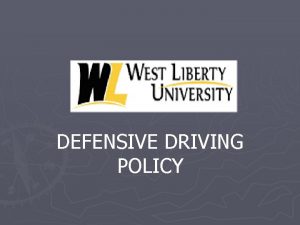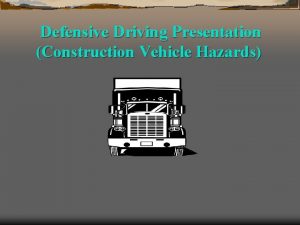Ch 11 Driving on Expressways 11 1 Characteristics



































- Slides: 35

Ch 11 Driving on Expressways

11. 1 Characteristics of Expressway Driving

Expressway Is a limited-access or controlled-access highway.

Types of Expressways n Interstate highways n Freeways n ______ n Parkways * Most of these terms are used interchangeably

Why do they have fewer collisions? 1. Cross traffic is ______ 2. Have a ______ or ______ to prevent head-on collisions 3. Pedestrians, no motorized vehicles, & slow moving vehicles are __________. 4. Wide shoulders and extra-wide underpasses for good ______ paths. 5. The are designed to help drivers ______ conditions well ahead.

Safe Driving Strategies & things to think about n Collisions are usually ______ on expressways. n You should travel at about the same speed as others n Too fast? n Too slow? n Always prepare for your trip! n ______– know route #, your entrance and exit # n ______– Plan stops for food, fuel, and rest

Safe Driving Strategies & things to think about continued… n Make every effort to stay ______ n Keep vehicle in ______ condition n Build ______ n Cooperate with other drivers n ROAD RAGE!!!

11. 2 Entering an Expressway

3 parts of expressway entrances. 1. 2. 3. ______________


Entering an expressway 1. Make sure it is the proper _______ 2. Signal “left” and check over your shoulder to find a gap in traffic. 3. Once in acceleration lane, gradually _______ your speed while glancing over your “left’ shoulder. 4. In the merging area adjust speed to match the traffic flow & position your vehicle at a safe interval behind the car you plan to follow and merge smoothly. 5. When on expressway, _______ your signal and adjust to the speed of traffic.

Entrance Ramp Problems n Short entrance ramps, short acceleration lanes, and high dividing walls. n If you choose the wrong entrance ramp ______ back up on to an entrance or exit ramp. n Some ramps you are very close to the merge area before you can see the expressway (______ your speed)

11. 3 Strategies for Driving on Expressways

Lane Choice n Right lane is for ______ , ______ and ______ n Left is for ______ n Avoid driving between 2 ______ vehicles n Trucks typically are ______ allowed to drive in the left lane

Signs, Signals, & Roadway Markings n Part of your lane choice is based on information from expressway signs, signals and roadway markings. n Some have express lanes that have few entrances and exits to ease the flow of traffic n Go to page 231

Wolf Pack n Group of vehicles ______ in a ______ on an expressway n Responsible drivers try to avoid them thus reducing their chances of conflicts. n Adjust speed to avoid these “wolf packs”

Following n High speeds of expressway traffic demand that you maintain at least a ______ second following distance n Increase to ______ or more seconds if: – Following a large vehicle that is blocking your sight – Following a motorcyclist – Bad weather – Being tailgated – Driving a heavy vehicles

Blind Spots n Don’t forget about them! n Try to _______ of other vehicles blind spots!

Lane Changing n Avoid changing lanes too ______ n Unnecessary weaving from one lane to another can lead to a ______

Passing and Being Passed n Is usually _______ on expressways then on a 2 -lane road. n If you are continually being passed on the right, move to the lane on your right when it is safe to do so.

11. 4 Exiting Expressways

Deceleration Lane n Is an added lane in which to slow your vehicle without blocking the vehicles behind. n Try not to _______ until you are off the expressway and in the deceleration lane

Exit Ramp n Is the ramp _______ off an expressway. n Make sure you identify the ramp speed. n Many lead to very sharp curves. * If you miss your exit go to the _______ and turn around. _______ back up!!!

Steps for Exiting 1. At least ____ mile before the exit start moving into the lane in which you will be exiting from. Change ____ lane at a time!!! 2. Move into the deceleration lane 3. Slow down gradually 4. Identify ramp speed sign, and adjust to the posted speed limit.

Exiting Problems n Someone may decide to get off last minutes and cut you off! n Ramp over flow – What to do? n Short deceleration lane – ______________

11. 5 Special Expressway Problems

________ Drowsy or trancelike conditions caused by concentration on the roadway ahead and monotony of driving

Fall-Asleep Collisions n More than _______ collisions in the United States each yeah are cause by sleepiness. n Fall-asleep collisions are _______ as likely to involve fatalities as other types of collisions

Expressways Through Cities n Have ______ exit and entrances ramps than rural expressways. n More ramps ____ merging traffic conflicts n Know in advance where you want to exit

Tollbooths n Are located along many expressways. n You stop at a tollbooth and pay a fee, or toll, for driving on that expressway. n _______– warn you of the tollbooths ahead and remind you to check your speed n When approaching look for signs ahead warning you which ones are token, cash, EZ Pass, open, and or closed.

Types of Tollbooths n Automatic n Operated by an attendant n Electronically

Controlled-Access Highway Is a highway that vehicles can enter and exit only at interchanges.

Entrance Ramp Gives you time to evaluate zone conditions and determine the best speed as you prepare to enter the expressway

Acceleration lane Is usually long enough for you to search for a gap in which to merge and accelerate to the speed of traffic.

Merging Area Is the 3 rd part of an expressway entrance where vehicles blend into the expressway traffic.
 What are three possible exiting problems?
What are three possible exiting problems? Characteristics of expressway driving
Characteristics of expressway driving As you enter the deceleration lane or the exit ramp
As you enter the deceleration lane or the exit ramp You are driving down the road
You are driving down the road Leave yourself a way out
Leave yourself a way out What is a visual lead
What is a visual lead Indeshaw adenaw
Indeshaw adenaw Crash costs are measured in dollars and in
Crash costs are measured in dollars and in Inattention blindness
Inattention blindness Defensive driving toolbox talk
Defensive driving toolbox talk Driving tools in carpentry
Driving tools in carpentry Drivers manual nj
Drivers manual nj Michigan state police teenage defensive driving
Michigan state police teenage defensive driving What is space management in driving
What is space management in driving 6 driving conditions
6 driving conditions A paragraph
A paragraph Sign shapes meaning
Sign shapes meaning Front limit reference point
Front limit reference point Left driving countries
Left driving countries Youtube youtube
Youtube youtube No texting while driving app inventor
No texting while driving app inventor Hand signals for backing up a truck
Hand signals for backing up a truck Driving forces of csr
Driving forces of csr Google self driving car ppt
Google self driving car ppt Driving force of plate tectonics
Driving force of plate tectonics Pngc
Pngc Smith system in driving
Smith system in driving Driving force
Driving force How can you best use the ipde process in city driving
How can you best use the ipde process in city driving Chapter 1 managing risk when driving
Chapter 1 managing risk when driving Ipde steps
Ipde steps 12-15 second range
12-15 second range Spider method driving steps
Spider method driving steps Ict driving licence
Ict driving licence How is math used in driving
How is math used in driving Passengers can help a driver better manage emotions by
Passengers can help a driver better manage emotions by
